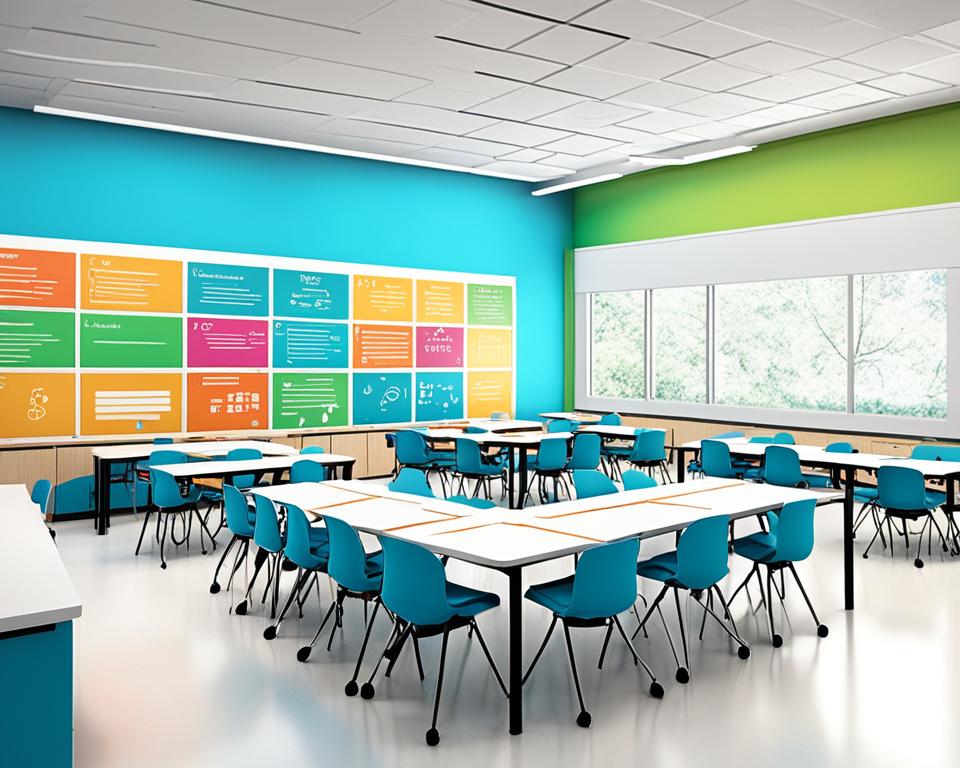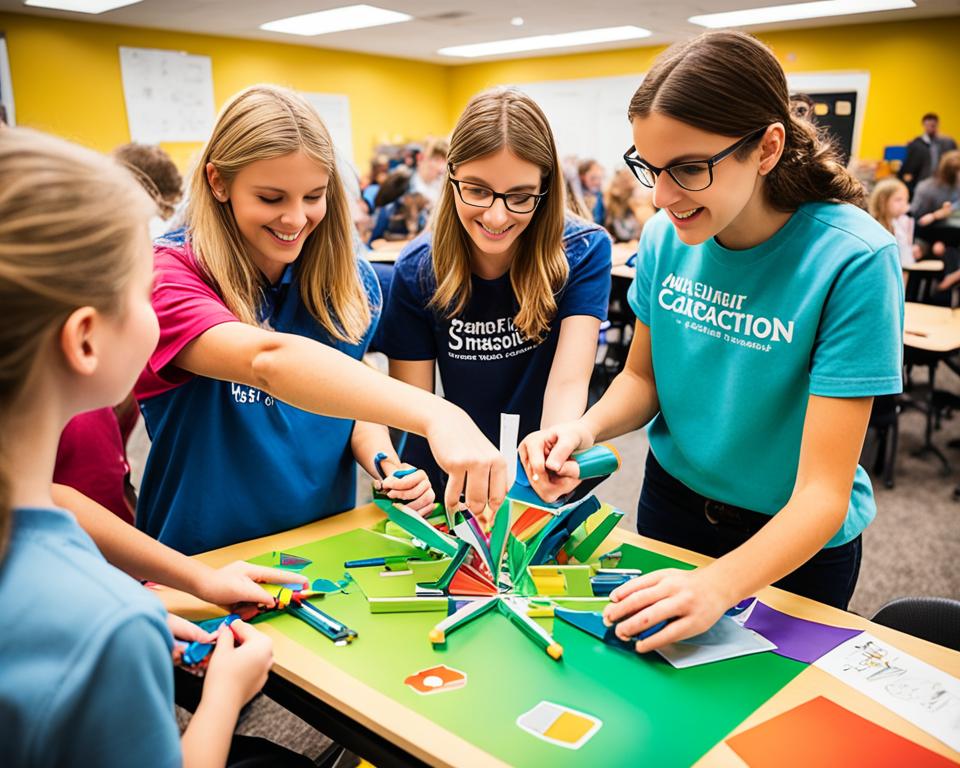Education forms the bedrock of progress and innovation, and as we navigate the complexities of the modern world, it is paramount that we empower minds through innovative approaches to creative learning. Creative education programs offer learners unique and dynamic experiences, fostering creativity, critical thinking, and problem-solving skills. These programs revolutionize traditional educational approaches by integrating interactive and experiential learning methods, ensuring that learners are equipped with the tools they need to thrive.
Key Takeaways:
- Creative education programs provide learners with innovative and engaging learning experiences.
- These programs foster creativity, critical thinking, and problem-solving skills.
- Interactive and experiential learning methods are integrated into creative education programs.
- Empowering minds through creative learning prepares learners for the complexities of the modern world.
- Creative education programs revolutionize traditional educational approaches.
Transforming Education Through Creative Learning Models
In today’s rapidly changing educational landscape, creative learning models are revolutionizing traditional teaching approaches and transforming education as we know it. These innovative models prioritize experiential learning, project-based learning, and interactive workshops to engage students in immersive and dynamic educational experiences.
One of the key aspects of creative learning models is the emphasis on interactive workshops and imaginative educational initiatives. These initiatives provide students with hands-on experiences that stimulate their creativity, allowing them to explore their interests and passions in a practical and engaging manner. By actively participating in these workshops, students are able to collaborate with their peers, develop problem-solving skills, and tackle real-world challenges.
Project-based learning is another essential component of creative learning models. This approach immerses students in a hands-on curriculum that encourages critical thinking, creativity, and innovation. By working on projects that require research, analysis, and problem-solving, students develop a deep understanding of the subject matter and develop transferable skills that can be applied in various contexts.
With these creative learning models, education becomes more than just acquiring knowledge; it becomes a transformative experience that prepares students for the demands of the 21st century. By integrating experiential learning, project-based learning, and interactive workshops into the curriculum, educators can nurture students’ creativity, critical thinking, and problem-solving abilities, empowering them to become lifelong learners and adaptable individuals in an ever-evolving world.
The Role of Creativity in Shaping Future Learning Environments
Creativity plays a crucial role in shaping future learning environments. By integrating creative thinking skills into curriculum design and teaching practices, educators can create learning environments that foster innovation, adaptability, and resilience. These environments empower students to think critically, embrace change, and develop the skills necessary to thrive in a rapidly evolving world.
As we prepare learners for the future, it is essential to recognize the transformative power of creativity in education. Creativity enhances educational experiences by encouraging students to explore, experiment, and express themselves. It ignites their curiosity, fosters a growth mindset, and nurtures their ability to think outside the box.
One of the key benefits of incorporating creativity into learning environments is the development of critical thinking skills. By encouraging students to approach problems creatively, educators empower them to analyze, evaluate, and generate innovative solutions. These skills are vital in a world that values adaptability, agility, and problem-solving abilities.
“Creativity is intelligence having fun.” – Albert Einstein
Furthermore, creativity in education enables learners to embrace change and uncertainty. In an increasingly interconnected and fast-paced world, students must be equipped with the adaptability and resilience to navigate through complexities and embrace emerging opportunities. By fostering creativity, educators empower students to embrace challenges, take calculated risks, and persevere in the face of adversity.
The integration of creativity also fosters collaboration and communication skills. As students engage in creative projects and activities, they learn to work effectively in teams, listen to different perspectives, and communicate their ideas with clarity and confidence. These skills are crucial in preparing them for future collaborative work environments that require cross-functional teamwork and effective interpersonal skills.
“Creativity is the power to connect the seemingly unconnected.” – William Plomer

In conclusion, creativity is a catalyst for shaping future learning environments. By nurtu
Creating Dynamic Educational Experiences with Experiential Learning
Experiential learning is a powerful approach that creates dynamic educational experiences, fostering creativity, critical thinking, and problem-solving skills. Through interactive workshops and imaginative educational initiatives, learners engage in hands-on activities that allow them to apply their knowledge in real-world settings. These initiatives promote a deeper understanding of concepts and enhance long-term retention by providing practical and immersive learning experiences.
Interactive Workshops and Imaginative Educational Initiatives
Interactive workshops and imaginative educational initiatives are key components of experiential learning. These initiatives engage learners in interactive activities that require active participation and collaboration. Through these workshops, students have the opportunity to explore and solve real-world problems, enhancing their critical thinking and problem-solving skills. By encouraging creativity and innovation, interactive workshops and imaginative educational initiatives empower learners to think outside the box and develop practical skills applicable in various contexts.
Project-Based Learning and Hands-On Curriculum
Project-based learning and hands-on curriculum further enhance the experiential learning process. By immersing students in real-world projects and activities, they are challenged to collaborate, innovate, and create solutions. Project-based learning encourages critical thinking, problem-solving, and creativity by presenting learners with authentic and complex problems to solve. Hands-on curriculum allows students to actively explore and manipulate materials, fostering a deeper understanding of concepts and theories. These experiential learning methods cultivate skills that are valuable in both academic and professional settings.
| Experiential Learning | Traditional Learning | |
|---|---|---|
| Engagement | Active participation and immersive experiences promote higher engagement. | Passive absorption of information can lead to lower engagement. |
| Retention | Hands-on application and real-world context enhance long-term retention. | Memorization of facts and theories may result in limited retention. |
| Skills Development | Promotes creativity, critical thinking, problem-solving, and collaboration skills. | Focuses primarily on acquiring knowledge without emphasizing application or skill development. |
| Real-World Relevance | Opportunities to apply knowledge and skills in real-world contexts. | May lack real-world relevance, leading to a disconnect between learning and application. |
The Impact of Artistic Learning Opportunities on Student Engagement
STEAM Education: Merging Arts with Science and Technology
Artistic learning opportunities have a profound impact on student engagement. By integrating arts into education, we enhance learning outcomes and promote creativity. One such approach is STEAM education, which merges arts with science and technology to provide students with a holistic learning experience.
STEAM education goes beyond traditional STEM subjects by incorporating the arts, such as visual arts, music, and drama, into the curriculum. This interdisciplinary approach fosters creativity, critical thinking, and innovation. Students not only develop technical skills but also learn to express themselves creatively and think outside the box.
Imagination-Focused Curriculum and Its Benefits
An imagination-focused curriculum is another powerful way to enhance student engagement. By incorporating artistic elements and encouraging creative expression, we ignite students’ imagination and empower them to explore their unique ideas.
An imagination-focused curriculum nurtures students’ creativity and allows them to bring their imagination to life through various forms of artistic expression, such as drawing, painting, storytelling, and role-playing. This approach encourages students to think beyond what is immediately apparent, enabling them to approach challenges with innovative solutions.
When students have the freedom to explore their imagination and express themselves creatively, they become more engaged and invested in the learning process. Imagination-focused curriculum not only enhances student engagement but also cultivates essential skills such as critical thinking, problem-solving, and communication.
Fostering Creative Thinking Skills for Problem Solving
Creative thinking skills are essential for problem-solving. In this section, we will delve into how educators can foster creative thinking skills to enhance students’ problem-solving abilities. By promoting curiosity, open-mindedness, and divergent thinking, educators can empower students to approach problems creatively and find innovative solutions. Creative thinking skills enable learners to think outside the box, consider multiple perspectives, and overcome challenges with creativity and resilience.

Developing creative thinking skills is a valuable asset for students as they navigate the complexities of the modern world. By encouraging creative thinking, educators nurture students’ ability to approach problems from different angles and explore unconventional solutions.
Here are some strategies that educators can use to foster creative thinking skills:
- Encourage curiosity: Foster a sense of wonder and the desire to explore by encouraging students to question and investigate. Curiosity leads to the discovery of new ideas and perspectives.
- Promote open-mindedness: Help students develop a willingness to consider different viewpoints and challenge their own assumptions. This mindset encourages creativity and avoids rigid thinking.
- Emphasize divergent thinking: Encourage students to generate multiple ideas and explore various possibilities. Divergent thinking enables creative problem-solving by expanding the range of solutions.
- Provide opportunities for creative expression: Offer students outlets for their creativity, such as art projects, writing assignments, or brainstorming sessions. This allows them to explore and develop their creative abilities.
“Creativity is inventing, experimenting, growing, taking risks, breaking rules, making mistakes, and having fun.” – Mary Lou Cook
Through these strategies, educators can create an environment that nurtures creative thinking and empowers students to become effective problem solvers.
Empowering Educators: The Pivot to Innovative Teaching Models
Educators play a crucial role in empowering students through innovative teaching models. By embracing technology and interactive learning, educators can enhance the teaching and learning experience, fostering a creative and engaging educational environment. Integrating technology into the classroom allows for personalized learning, collaboration, and access to a wealth of educational resources. Through innovative learning initiatives, educators can develop their own creative skills and acquire the necessary tools and strategies to inspire creativity and critical thinking in their students.
Integrating Technology and Interactive Learning in the Classroom
Technology has revolutionized the classroom, opening up new avenues for interactive learning. By incorporating technology into their teaching practices, educators can engage students in dynamic and immersive learning experiences. Interactive educational tools, such as interactive whiteboards and educational apps, enable students to actively participate in the learning process, fostering a deeper understanding of the subject matter. Furthermore, technology facilitates personalized learning, allowing educators to tailor instruction to individual students’ needs and learning styles. By integrating technology into the classroom, educators can create a student-centered learning environment that promotes creativity, critical thinking, and collaboration.
Developing Creative Skills through Innovative Learning Initiatives
Innovative learning initiatives provide educators with opportunities to enhance their own creative skills while equipping them with the tools and strategies necessary to foster creativity in their students. Professional development programs and workshops offer educators the chance to explore innovative teaching methods and learn from experts in the field. These initiatives not only empower educators to be more creative and adaptable in their teaching practices but also enable them to inspire creativity and critical thinking in their students. By incorporating innovative learning initiatives, educators can create an educational environment that nurtures creative skills development and prepares students for success in a rapidly changing world.
Creative Education Programs: Designing Pathways for Empowerment
Creative education programs play a critical role in empowering learners by providing them with unique opportunities for growth and development. These programs are designed to go beyond traditional educational approaches, offering innovative pathways that foster creativity, critical thinking, and problem-solving skills. By integrating experiential education methods and customizing learning strategies, creative education programs maximize engagement, motivation, and learning outcomes, ultimately preparing learners for success in the modern world.
Educational Enrichment through Experiential Education Methods
Experiential education methods are a cornerstone of creative education programs. These methods include internships, field trips, and immersive learning experiences that provide students with real-world contexts to apply their knowledge and skills. By engaging in hands-on activities, students gain practical experience, develop a deeper understanding of concepts, and enhance their problem-solving abilities. Experiential education methods enrich the educational journey by bridging the gap between theory and practice, ensuring that learners are well-prepared for real-world challenges.

Customizing Learning Strategies to Foster Educational Excellence
Customized learning strategies are another key component of creative education programs. Recognizing that each learner is unique, these programs tailor their approaches to meet the individual needs and strengths of students. By personalizing the learning experience, creative education programs maximize engagement and motivation, allowing learners to thrive and achieve educational excellence. Customized learning strategies can include adaptive learning technologies, differentiated instruction, and project-based learning, among others. These strategies empower learners to take ownership of their education and develop the skills necessary to succeed in a rapidly evolving world.
Cultivating a Mindset for Continuous Learning and Innovation
In today’s rapidly changing world, cultivating a mindset for continuous learning and innovation is crucial. As educators, it is essential to promote an educational culture that embraces creativity, encourages continuous learning, and fosters innovation. By creating an environment that values creativity, risk-taking, and adaptation, educators can empower students to embrace lifelong learning and develop the skills necessary for success in the 21st century.
To promote an educational culture that encourages creativity, educators can implement various strategies. Incorporating open-ended projects and problem-solving activities into the curriculum allows students to think critically, explore their creative potential, and develop innovative solutions. Providing opportunities for collaboration and cross-disciplinary learning can also inspire creativity and innovation by exposing students to diverse perspectives and ideas.
Adapting teaching approaches to meet the changing learning landscape is equally important. As technology continues to evolve, educators must integrate digital tools and resources into their teaching practices. This can include using interactive educational software, online learning platforms, and virtual reality experiences to create engaging and interactive learning environments. By embracing technology, educators can enhance student learning experiences and prepare them for a digital and globally interconnected world.
Furthermore, educators should continuously update their teaching approaches to meet the evolving needs and preferences of their students. This can involve incorporating student-centered learning methods, such as flipped classrooms or project-based learning, that promote active engagement and personalized learning experiences. By adapting teaching approaches, educators can create a dynamic and inclusive learning environment that caters to the diverse learning styles and interests of their students.
By cultivating a mindset for continuous learning and innovation, educators can help students develop the skills necessary to thrive in an ever-changing world. Through promoting an educational culture that encourages creativity and adapting teaching approaches to meet the changing learning landscape, educators can empower students to become lifelong learners who are adaptable, innovative, and prepared to succeed in the future.

Global Collaboration: Preparing Students for an Interconnected World
In an interconnected world, global collaboration is essential. This section will focus on how educators can prepare students for global collaboration by fostering collaboration skills, cultural competency, and global awareness. By engaging in collaborative projects with peers from around the world, students develop the skills necessary to work effectively in diverse teams, understand different perspectives, and contribute positively to global challenges. Global collaboration prepares students to thrive in a globalized society and make a meaningful impact on a global scale.
Conclusion
In conclusion, this article has explored the key insights and themes surrounding creative education programs and innovative learning approaches. We have highlighted the importance of these programs in nurturing imagination, fostering innovation, and enhancing creative skills among learners of all ages. By embracing creativity and creating a culture of continuous learning and innovation, we can empower minds to thrive in an ever-changing world.
Throughout the article, we have seen how interactive workshops, project-based learning, and hands-on curriculum engage learners in dynamic educational experiences that promote critical thinking, problem-solving, and creativity. These innovative approaches to learning not only enhance student engagement but also prepare them for the challenges of the future.
Furthermore, we have explored how creativity plays a vital role in shaping future learning environments. By integrating creative thinking skills into curriculum design and teaching practices, educators can create an educational culture that fosters innovation, adaptability, and resilience. This equips learners with the necessary skills to navigate a rapidly evolving world.
In summary, creative education programs and innovative learning approaches have the power to empower minds and shape a generation of learners ready to embrace the complexities of the modern world. By fostering creativity, critical thinking, and problem-solving skills, we can unleash the full potential of learners and prepare them for a future where innovation and creativity are paramount.
FAQ
What are creative education programs?
Creative education programs are innovative learning initiatives that provide learners with unique and dynamic learning experiences, fostering creativity, critical thinking, and problem-solving skills.
How do creative learning models transform education?
Creative learning models transform education by integrating interactive workshops and imaginative educational initiatives, engaging learners through hands-on experiences that stimulate creativity and innovation.
How does experiential learning enhance the educational experience?
Experiential learning enhances the educational experience by engaging learners in interactive workshops and imaginative educational initiatives, providing them with real-world experiences that promote creativity, critical thinking, and problem-solving skills.
What is the impact of artistic learning opportunities on student engagement?
Artistic learning opportunities have a profound impact on student engagement, igniting imagination, and fostering creativity through STEAM education and imagination-focused curriculum.
How can educators foster creative thinking skills?
Educators can foster creative thinking skills by promoting curiosity, open-mindedness, and divergent thinking, empowering students to approach problems creatively and find innovative solutions.
How can technology enhance the teaching and learning experience?
Integrating technology into the classroom allows for personalized learning, collaboration, and access to a wealth of educational resources, enhancing the teaching and learning experience.
How do creative education programs design pathways for empowerment?
Creative education programs design pathways for empowerment by providing learners with unique opportunities for growth and development through experiential education methods and customized learning strategies.
How can educators cultivate a mindset for continuous learning and innovation?
Educators can cultivate a mindset for continuous learning and innovation by fostering an environment that values creativity, risk-taking, and adaptation, preparing students for success in a rapidly changing world.
How can educators prepare students for global collaboration?
Educators can prepare students for global collaboration by fostering collaboration skills, cultural competency, and global awareness through collaborative projects with peers from around the world.
Source Links
- https://www.linkedin.com/pulse/unleashing-creativity-empowering-minds-through-carlos-chávez
- https://medium.com/@nlpwithpurpose/empowering-minds-the-role-of-creativity-and-creative-thinking-skills-for-educators-and-trainers-409e00cf2561
- https://thinktechhawaii.com/empowering-minds-innovation-in-education-the-creative-life/

